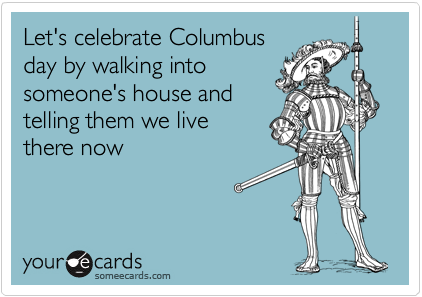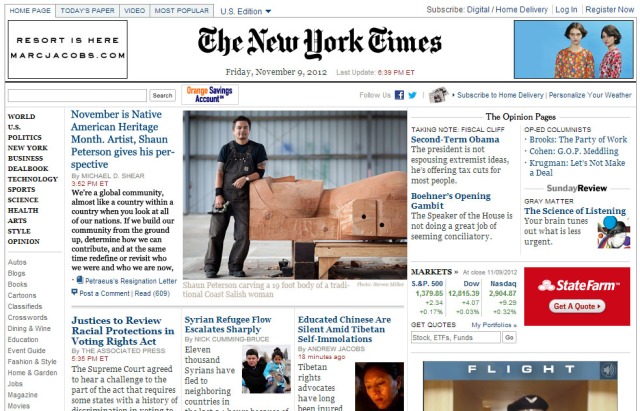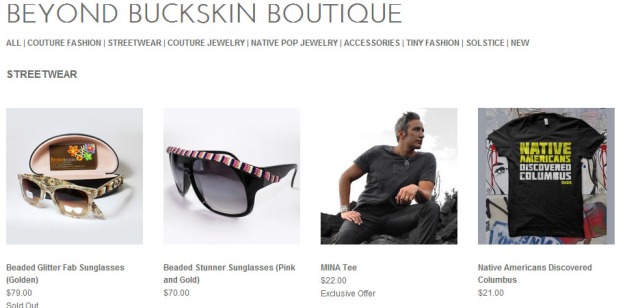I sat down with Turtle Mountain Chippewa Fashion Blogger, Jessica Metcalfe to talk about Native American Heritage Month. The interview touches on the meaning of Heritage Month, working with the media industry, misappropriating Native Culture through fashion, and building her fashion blog empire. Each week during the month of November, you can read these interviews on the NATIVE(X) blog. (Part two of a six part series.)
Mac: What does Native American Heritage Month mean to you?
Jessica: Well, I’m Native American, and so every month is ‘Native American Heritage Month’ to me. I didn’t really know that it existed – as an official ‘month’ – until I went to graduate school. We didn’t see November as a special month to educate people about Native American Heritage. It’s like a year round deal for most Native people. Then, when I went to graduate school we were like “hey, it’s Native American Month. Here’s our opportunity to educate people and reach broader audiences.”
The rest of society just decided like “Okay. Now, we learn about black people in February, and we learn about Indians in November.” It’s a weird concept to me. I mean it’s cool and it’s great, but it’s a weird concept.
And it’s proving to have no real impact, since mainstream media continues to perpetuate stereotypes about Native people (think of No Doubt’s recent video or Victoria’s Secret headdress faux pas) and disregard education.

We just have a huge problem with how Native people are represented in mainstream media.
Mac: What topics would you want the media to focus on for Native American Heritage Month?
Jessica: I think a main problem has to do with the fact that people just don’t know how to talk about Native American people or Native American history, oftentimes because it brings up historical events that were absolutely horrible. So people don’t know, Should we talk about how beautiful Native cultures are? Should we talk about the massacres? Should we talk about contemporary life?
Mac: If you could take over the homepage of CNN or the New York Time for a day during the month, what would you feature?
Jessica: I would highlight art. Because when you talk about art, you have to talk about education. You have to talk about religion and spirituality, the environment and ecology, and trade and economies. You also have to talk about history and pre-history. You have to talk about all of this stuff because people don’t know – but they want to know. You have to talk about and celebrate the diversity of the cultures.
Mac: So one of your main goals is educating people about the different tribes or different regions?
Jessica: Yeah, and the diversity of experience. The historical experiences were all different. I mean it’s such an amazing story. Whenever I teach classes the students are always there and always awake. I know that if students don’t find a class interesting they’ll skip it or sleep through it. So, I know that people are genuinely interested in learning about Native American Heritage. It’s just not provided for them in any in-depth kind of way. It’s not given to them in grade school or high school. For most students, it’s only offered in college, and if you sign up for those classes.
Mac: So how do you balance teaching about the historical injustices versus moving forward in present day life? For example, this year on Columbus Day Adrienne K of Native Appropriations celebrated the resilience of Native people instead of writing how horrible Columbus was.
Jessica: When you read Adrienne’s post, she wants to switch the narrative from just talking about how horrible Columbus was to how persevering our people are. However, we do still need to talk about how horrible Columbus was. We have to because if we all of a sudden exclude that information and just celebrate Native people, then there is this process of whitewashing history and looking at it through rose-colored glasses. And this is the case for so many of the massacres. They aren’t called a massacre in the history books. They call them battles. It’s not a battle when you murder women, children, and elderly, that’s not a battle. You’re massacring people. So, I think that we have to be very careful about how we talk about history and making sure that it isn’t just a white version, the whitewash version. But I agree with Adrienne, we should be talking about the fact that we’re still here. The fact that we’re still here is a form of resistance.

Mac: Switching things up here. How do you define patriotism?
Jessica: It’s like dual citizenship. I am member of Turtle Mountain Chippewa, but I am also a US citizen. I vote in the United States Election because I know that the outcome of those elections affect me as well.
One interesting thing about ‘patriotism’ is the fact that we have so many warriors who sign up for the services. We have the highest percentage of service members out of all ethnic groups because, at the end of the day, this is our land. This is our place. This is us. I still walk outside barefoot because you have to have that connection to the land, the grass. You still had to have that connection and you have to fight for it. It’s a source of pride for all of us. It’s not about fighting for the United States, or fighting for Obama or whatever. It is fighting for us, so that we can remain here which is all that we want.
Mac: What are you trying to accomplish with Beyond Buckskin?
Jessica: Well, a lot! There are two prongs. The first is to put Native American artists and designers at the center. The fashion industry is one of the hardest industries to break into regardless of your background.
Beyond Buckskin is about creating a platform for emerging or established designers to take their careers to the next level. It’s about spotlighting them, encouraging them, and providing economic opportunities for them. Eventually, I want to set up a mechanism where they can get grant money through Beyond Buckskin for whatever project they’re working on. That’s my dream- to be able to create an entity that is all about pushing Native fashion forward.
So, the boutique plays an essential role in that–a stage where we can sell and people can buy Native-made fashion. We’ve sold over 850 items so far through the boutique.
Mac: Congratulations!
Jessica: It blows my mind. That means there are 850 more items out there in the world made by creative Native designers.
That’s one prong. The other prong has to do with educating about Native American Clothing Traditions, Contemporary Native American Fashion, but also representation of Native American culture in the fashion industry. The whole second aspect has to do with not only education, but making sure that we can connect these designers and artists with as many resources as possible so that the rest of the world can have access to these designers and see that our cultures are thriving.
I also love writing historical posts because Native American people were so fashionable in the 1600s, 1700s and 1800s. I also critique mainstream representations of Native people. Somebody needs to critique this stuff. We [as Native people] critique Hollywood’s representation of the Native American, but we’re not doing it in fashion. Why not? It is the same thing. It’s the same stereotype and they’re both very damaging. That’s where I step in to make sure that the fashion industry isn’t being racist and this is where we get stuff like the Paul Frank episode.
Mac: The social boycott against Paul Frank (the apparel company, no longer affiliated with Paul Frank himself) you mobilized was pretty impressive. What has happened since the infamous “Dreamcatching Powwow”?
Jessica: The Paul Frank response has been amazing, absolutely amazing. They are going above and beyond. I have so much respect for that. They reached out to Adrienne and I. They have a whole program so they are going to collaborate with at least one Native American designer to create a small collection that will launch in a year. I sent them a list of potential names of who I think that would work great with them – they might not select anyone from this list, but this is exactly what I wanted to do—create opportunities for Native designers.
Adrienne and I will also be putting together a panel with the president of Paul Frank Industries to hopefully present during the MAGIC Trade Show in Las Vegas this February. We’re going to be talking about these issues and then also talking about the collaboration.
Mac: Where is Beyond Buckskin in 10 years? An international fashion brand? A non-profit?
Jessica: Absolutely, I want to create this mechanism where I can provide funding, grant money not loans, for Native people. I think we need a huge influx of money if we’re going to be able to compete in the fashion business.
And we don’t have access to that. Even if we had only $1,000 grants – that would be such a huge surge to small businesses that would just really set it off in the right direction.
We also want to do workshops, similar to what you are doing so that the young ones can be the next leaders in the fashion industry. That’s really important. We need to set it up so it’s easier for them to take the reigns as the next generation.
A little further out, I want to create a platform for Native designers internationally. I have all these lists of the things I want to accomplish in the next five to ten years, and it is big.









Thank you Mac! It was great chatting with you-
-Jessica
KUDOS
Pingback: The Meaning Behind Navajo Fashion’s Misunderstanding | Hypebeast
Pingback: SoRaspy - SoRaspy: The Meaning Behind Navajo: Fashion’s Misunderstanding
Pingback: Hypbeast Editorial | NATIVE(X)